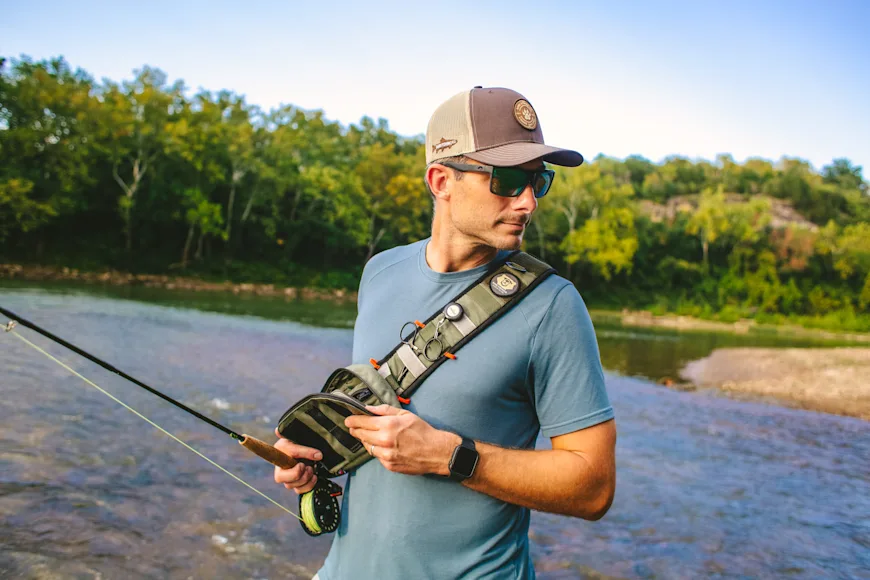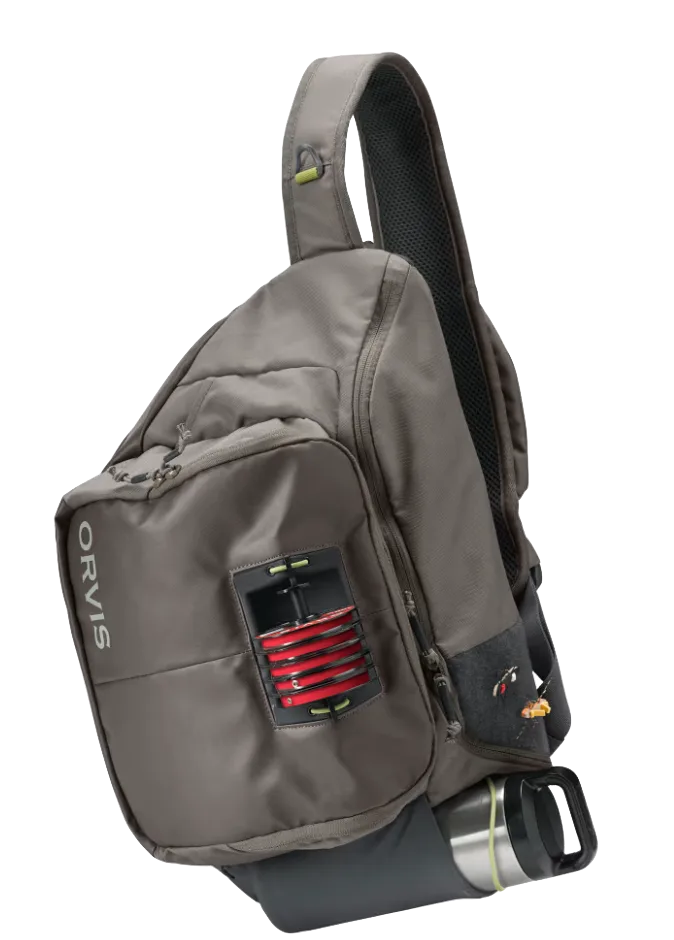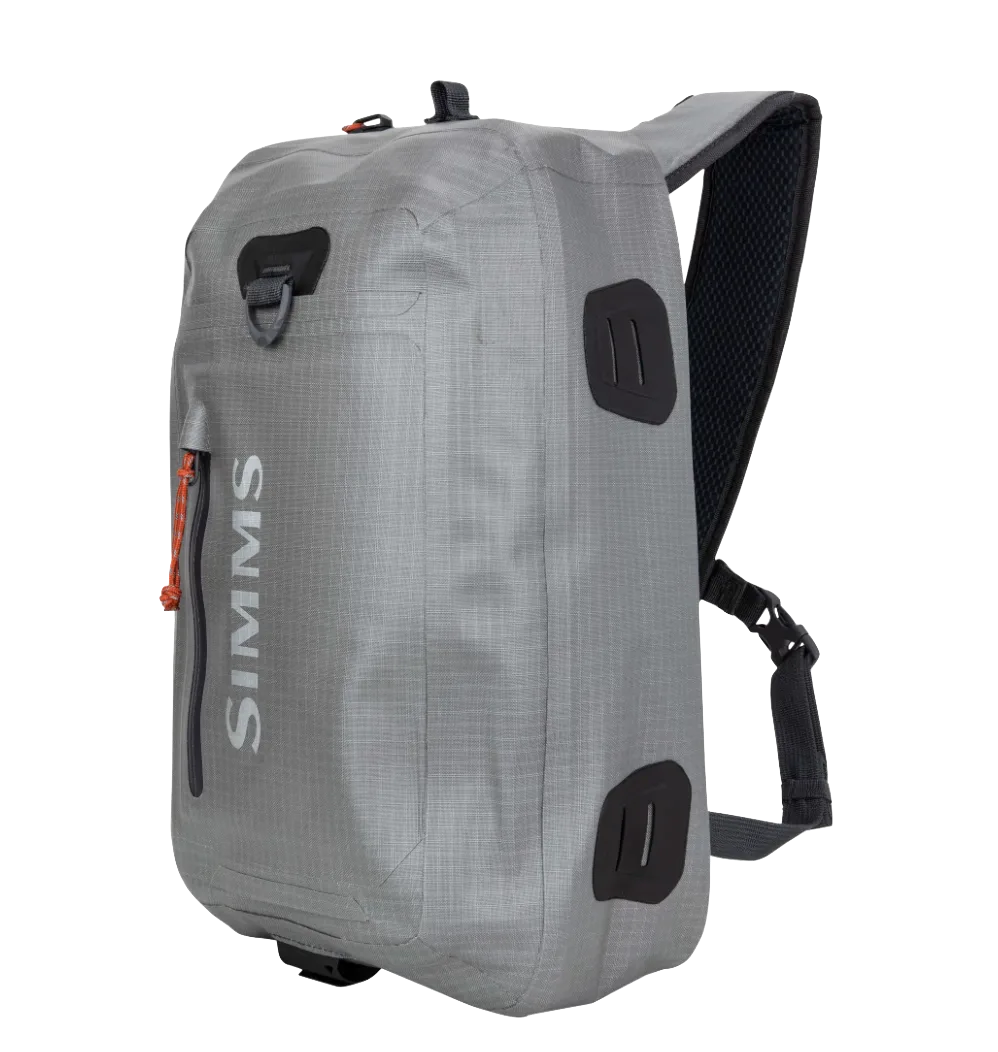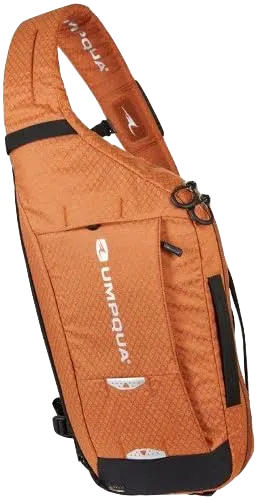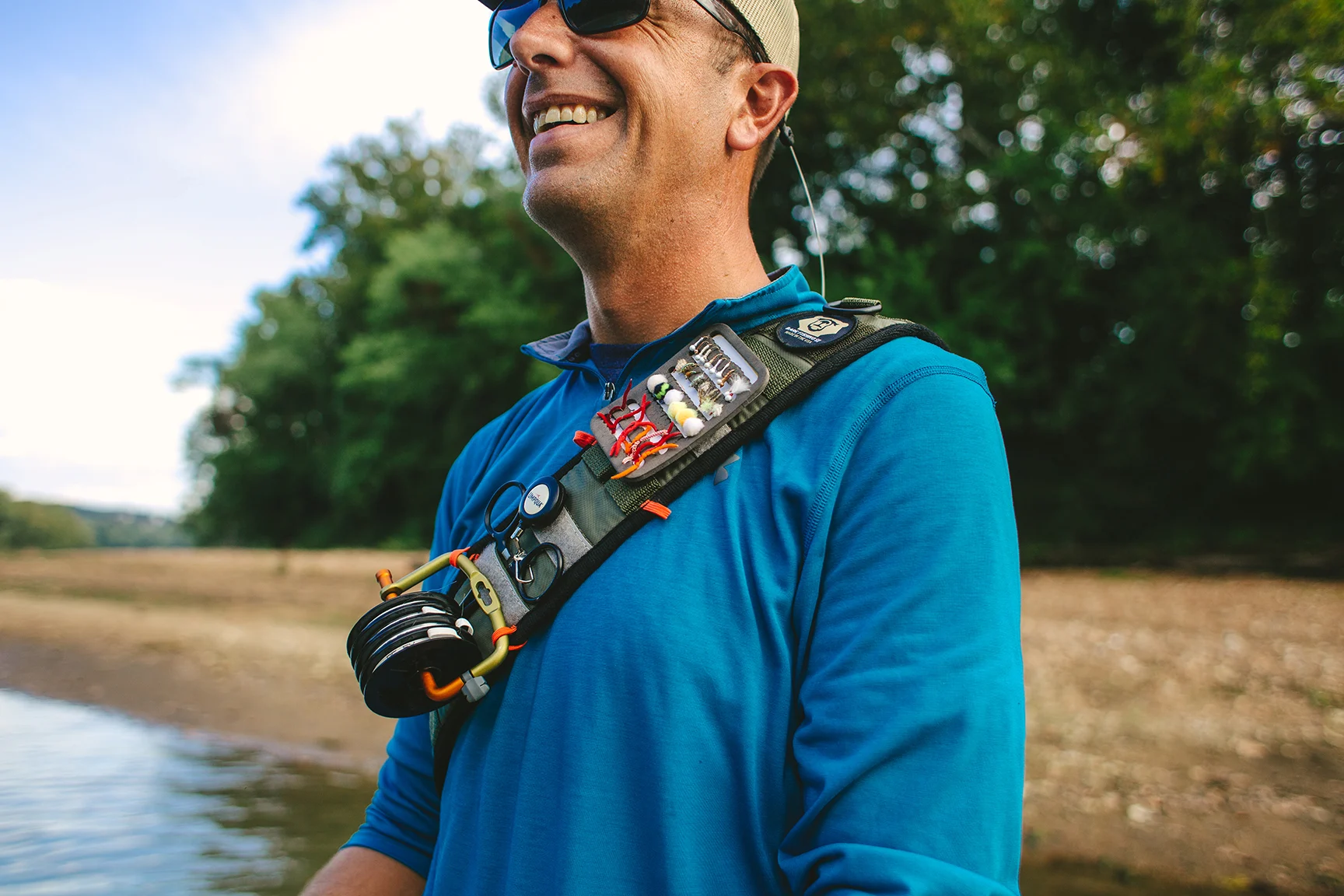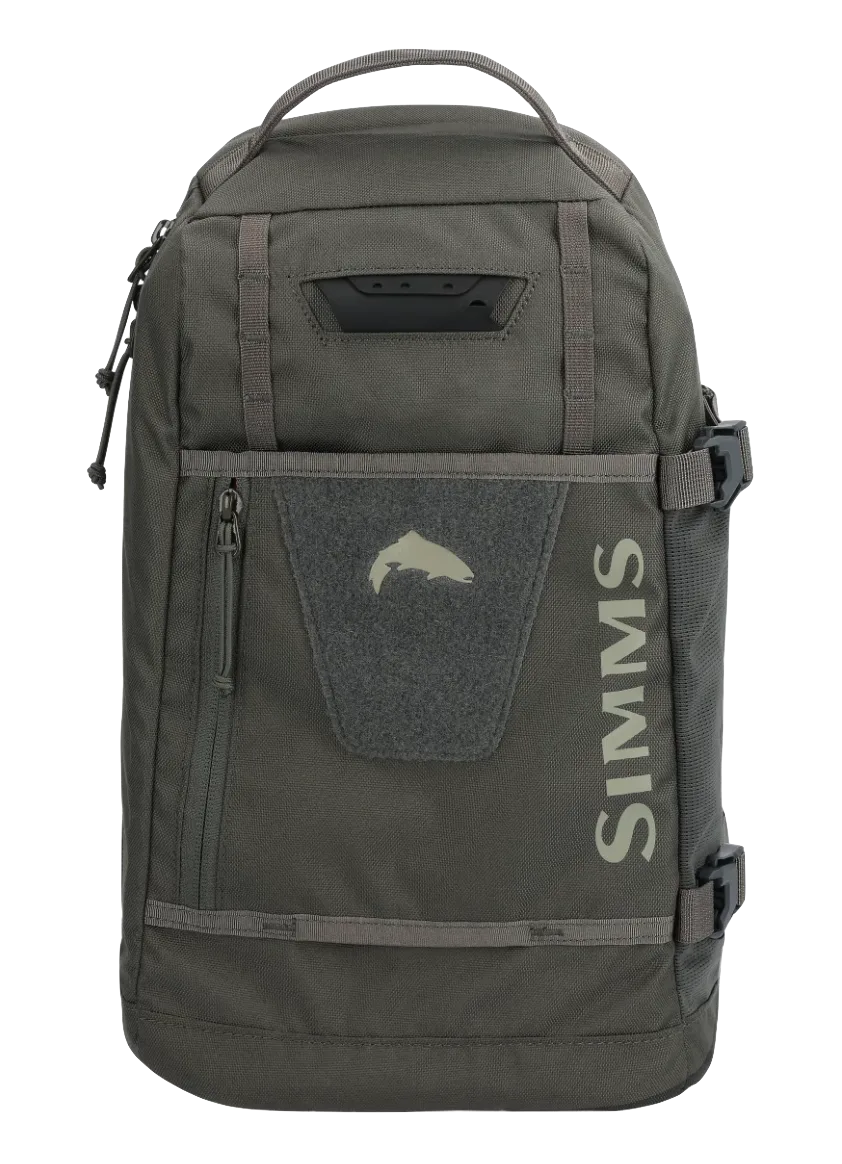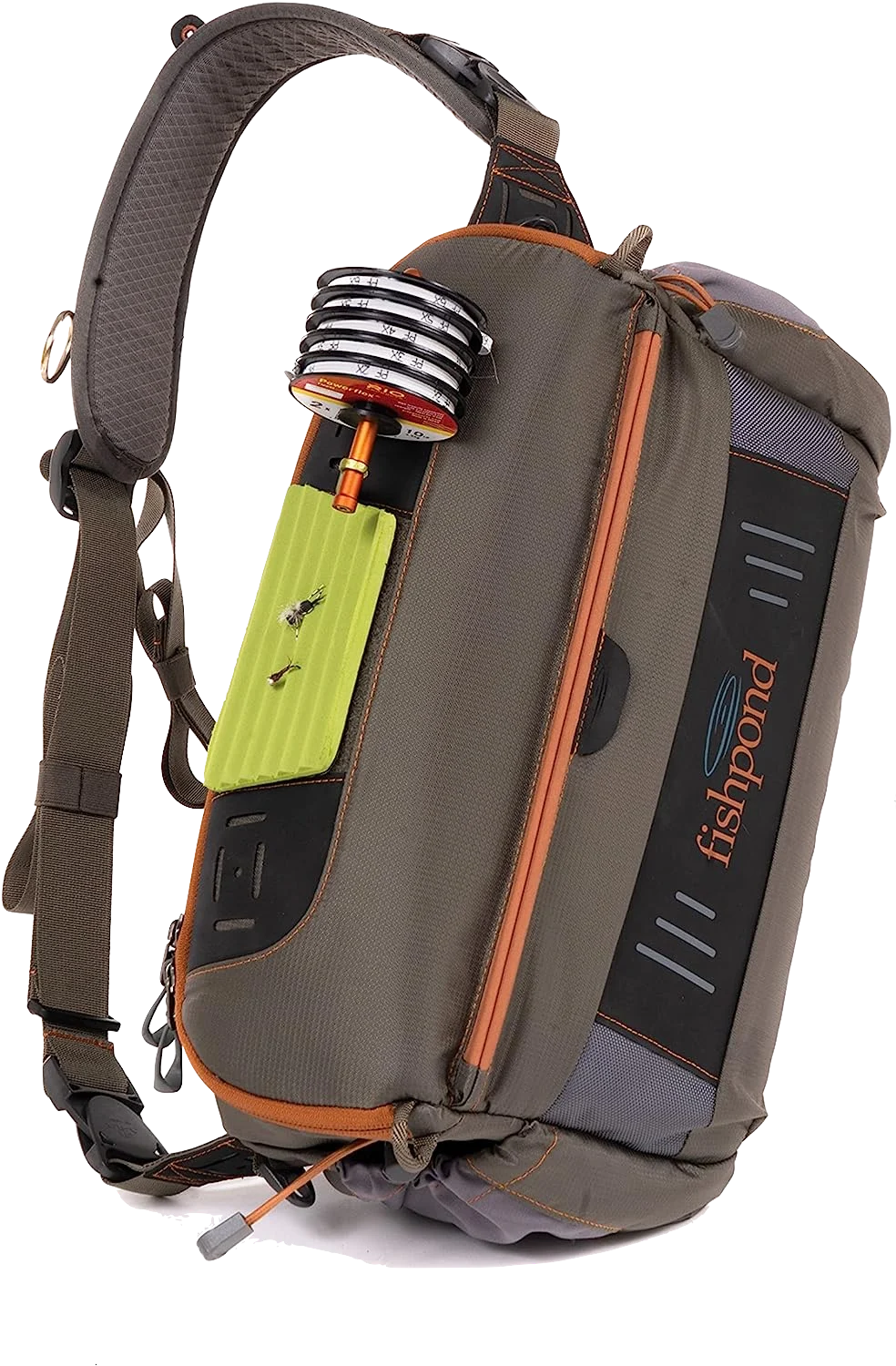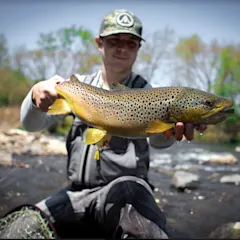We may earn revenue from the products available on this page and participate in affiliate programs. Learn more ›
Fly fishing sling packs fall somewhere between fishing backpacks and fly fishing vests. Smaller packs offer enough space for day trips without being too bulky to carry around all day. While larger sling packs give anglers the ability to hold plenty of boxes, rigging material, and even a rain jacket. Regardless of size, all sling packs keep your gear ready to go and in one place. We look for sling packs that are comfortable to wear, well-organized, and appropriately sized for specific styles of fishing. And we tested a number of the best sling packs over the last year—here are our favorites.
Best Overall: Orvis Guide Sling Pack
Best Minimalist Pack: Bare Fly Fishing Sling Pack
Best Waterproof: Simms Dry Creek Z Sling
Best for Lefties: Umpqua Switch 600 ZS
Best Value: Simms Tributary
Best with Net Holder: Fishpond Flathead
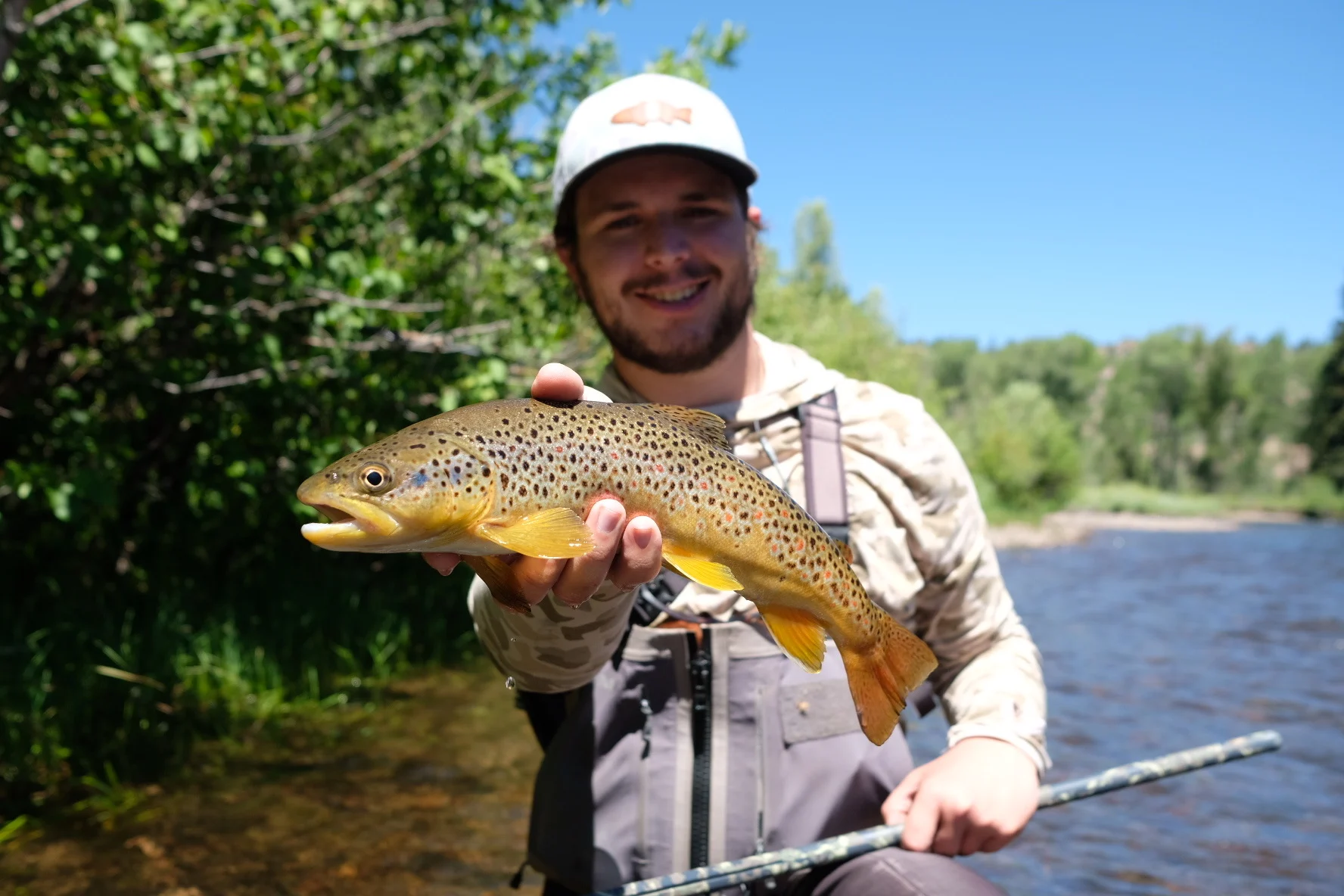
How We Picked the Best Fly Fishing Sling Packs
Sling packs are our preferred method of staying organized on the water. The combination of size and storage offers more than a vest without the added weight of a backpack. We find that a middle-of-the-road size pack gives us the ability to carry plenty of flies, a small camera, and lightweight rain gear without overloading. We tried lightweight slings for shorter outings and large packs for day trips. If we can only have one, we want something in the middle. Regardless of what size pack fits your needs, all good sling packs are durable, comfortable to wear, and well organized. We evaluated our selections on the following criteria:
Durability: How does the material hold up to the elements and constant use?
Comfortability: How comfortable are the pack and the pack strap?
Weight Distribution: Does the pack evenly distribute the weight of a full load?
Storage Capacity: How much storage does the pack have, and is it adequate for its design?
Internal Organization: Are the internal pockets and compartments laid out to maximize organization?
External Organization: What features, such as net holsters, tool clips, or tippet holders, are built into the pack's external portion?

Best Overall: Orvis Guide Sling Pack
Specs
Material: Recycled Eco Cordura
Weight: 1.76 lbs
Storage Capacity: 18 Liters
Pros
Plenty of compartments to keep gear organized
Strap pouch for the gear you use most
Easy-to-use tool holsters keep forceps and nippers secure
Cons
Can be heavy when fully loaded
The Orvis Guide Sling Pack is a one-stop option for anglers wanting to make the switch from a vest. The 18 liters of storage is divided into two main pockets. A larger main pouch is perfect for multiple fly boxes, an oversized streamer box, camera gear, or a riverside lunch. The secondary pouch has enough room for small fly boxes and all your other rigging materials. I find the internal zipper pockets work great to keep leaders, weights, and indicators separated.
Come time to rig a rod, the entire bag swings in front of you and acts as a workbench. The zipper pockets orient up so tippet, flies, and tools are easily accessible. My favorite feature of this pack is the shoulder strap and its built-in pouch. The shoulder pouch features a fly patch and a small zipper pocket for floatant and a few extra split shots. When time is of the essence, this little pouch keeps the essentials right where you need them. —Max Inchausti
Best Minimalist Pack: Bare Fly Fishing Sling Pack
Specs
Material: Sling Strap - 100 percent Nylon Pack Cloth, 100 percent polyester Spacer Mesh Knit Liner; Pack - 100 percent Nylon Fortress 1000 Denier, Pack Cloth Lining
Weight: Sling and Pack - 10.1 oz
Pros
Extremely lightweight and low-profile
Comfortable
Two foam fly pads included
Velcro patch
Additional accessories available
Made in the USA
Cons
Limited storage
There are lightweight and low-profile packs, and then there's the Bare Fly Fishing sling pack. As the name implies, this bare-bones fly fishing pack is built for the minimalist angler. It comes with one sling, one built-in pack with attachment straps, two foam pads, and a Velcro patch. When I picked one up for the first time, I thought there was no way it could hold all my gear, but I was wrong.
The pack forced me to filter out all the things I didn't need. That left me with a handful of flies, a tippet spool, nippers, pliers, indicators, leaders, and floatant. When I strapped it on my back for a day of fishing at my local stream, I couldn't believe how light (only 10 ounces) and comfortable it was. I barely noticed it was on my back while wading. Even better, my shoulder never got tired, and it felt as if I was casting without anything on my back.
The pack is designed to be used with attachments. Meaning you can customize it for your style of fishing. I rigged three different foam pads—one for nymphs, one for small streamers, and one for dry flies. I kept whatever foam pad I was mostly fishing Velcroed to the outside of the sling and the rest stored inside the bare pack. The only drawback is that you can't store bulky items like a water bottle, a rain jacket, or a big fly box. But the pack isn't designed to do that. It is made to simplify your setup. Now, the Bare Fly Fishing sling pack is my go-to small stream bag, and it comes with me on bigger trips when I might need to lighten my load for a backcountry adventure. —Ryan Chelius

Best Waterproof: Simms Dry Creek Z Sling
Specs
Material: Waterproof 420D Nylon Double Ripstop
Weight: 19.17 oz
Storage Capacity: 12L
Pros
Fully submersible
Comfortable to wear
Excellent internal storage
Cons
Expensive compared to other sling packs
I’ve always had two gripes with waterproof bags: the zippers and the storage. To get into early generation waterproof bags, you had to practically rip off the zippers and there was barely any storage. The Simms Dry Creek Z bag solved this with a TRU Zip zipper that glides along its tracks with minimal resistance. Inside the pack, there are three main storage areas. An internal zipper pocket holds smaller items like leaders and tippet spools. Two elastic pouches keep fly boxes secured at the top of the pack so you never have to dig for them. What’s left is the main pouch for valuables like camera gear or your phone. Total storage comes to 12 liters, and an external net sleeve holds all the gear you need for day trips. Traditional packs restrict how deep you can wade. The waterproof design allows you to reach deeper pockets others can’t reach. —M.I.
Best for Lefties: Umpqua Switch 600 ZS
Specs
Material: 420 Denier Nylon
Weight: 1.45 lbs
Storage Capacity: 10 liters
Pros
Reversible for left or right-handed use
Lightweight
Great for short minimalist trips
Cons
Only enough room for the essentials
Considering the difficulty left-handers have in other sports, fly fishing is pretty fair. Reels can be flipped easily, and rods are universal. But not sling packs. The single strap design makes it difficult for lefties to crossover. Most companies make a right-handed model and hope left-handed anglers will learn to deal with it.
Umpqua designed a reversible pack that is a mirror image of itself. No matter if you reel with your left or right hand, this pack will work for you. The Umpqua Switch 600 ZS has three pockets that are stacked on each to make up the pack’s body. The two-end pockets are made for low-profile items like leaders, weights, or tools. A center fly box pocket divides the accessory pockets in half. This creates a reversible pack that’s the same for left and right-handed people. To switch it, fold the strap over itself, and it is ready to go. I prefer this pack for quick outings where I know I just need the essentials. The lightweight, minimalist design is comfortable to carry and keeps gear organized. —M.I.
Best Value: Simms Tributary
Specs
Material: 600 Denier Recycled Polyester
Weight: 1.05 lbs
Storage Capacity: 10 Liters
Pros
Lightweight
Plenty of organizational pockets
Budget Friendly
Cons
Lacks features like tool holders or tippet tenders
Budget-friendly options are great for trying new pieces of gear before you go all in. For anglers looking to try sling packs, the Simms Tributary is a user-friendly and affordable option. Simms did not sacrifice the quality of this entry-level pack. The 600-denier polyester is lightweight and surprisingly strong for a pack that will last. Add that to the streamlined design, and it’s easy to forget you're wearing it. The bag storage is divided into one main pocket and a front-facing accessory pocket. It has plenty of room for several fly boxes while keeping your rigging materials separate. The external storage adds a water bottle holder and a net sleeve. Combining all these features helps new anglers stay organized at a budget-friendly price. —M.I.
Best with Net Holder: Fishpond Flathead
Specs
Material: 210D Recycled Nylon
Weight: 1.7 lbs
Storage Capacity: 10 Liters
Pros
Ambidextrous design
Features movable dividers
Made from otherwise unused commercial fishing nets
Cons
Slightly heavier than other packs this size
If you are a multispecies angler, it helps to have one pack that can adapt to different fly boxes and gear. The Fishpond Flathead pack is a customizable sling pack built for left or right-handed anglers. It has a large main pocket and a forward-facing magnetic pouch. For a personalized touch, Fishpond created removable Velcro dividers. You can position the dividers to fit different size fly boxes and gear. An organized pack keeps everything in the same place to cut down on time spent looking for equipment.
I switch back and forth between trout, musky, and saltwater fishing, so I need a pack that can do it all. Staying true to their conservation mission, each pack is made of recycled nylon from ghost nets found in the ocean. This material is both durable and comfortable to wear. The ambidextrous design allows anglers to flip over the shoulder strap to change the bag's orientation. Unlike other reversible packs, the net holder is also ambidextrous. The molded pack panel has left and right net slots to store a net at the base of the pack. This keeps the net firmly in place while dispersing the net’s weight evenly. —M.I.
What to Consider When Choosing a Fly Fishing Sling Pack
Sling packs have captured the market with their convenient organization and reduced weight. Their popularity gave rise to a variety of packs in different sizes, weights, and technologies. Some are waterproof for wading in deep water and others are built on a minimalist approach. The pack that suits you best should meet the comfort, size, and organization demands of your fishing style.
Comfort
Sling packs are made from a variety of materials depending on their design and use. Pack weight is critical when talking about overall comfort. The size of a pack can be deceiving. While some packs may be close in size, the difference in construction can be several ounces. Lighter packs take the strain off your shoulders during a long day of fishing. Since sling packs have one main strap, the design, quality, and weight distribution are essential for comfort. I prefer a padded main strap with a side support strap to disperse the weight of a fully loaded pack.
Size
The majority of sling packs can be broken down into small, medium, and large sizes. Larger sling packs have several pockets for multiple fly boxes, leaders, weights, and tools. They are great for overnight trips or technical fisheries where you’re not sure what’s going to work. Anglers sneaking out after work favor small, minimalist packs. They offer simplicity in a comfortable and easy-to-carry package. If I was only limited to one size, I’d settle for something in the middle. A medium-sized pack carries plenty of gear while remaining organized and comfortable to carry.
Organization
The most important part of selecting a pack is internal organization. While style and design look cool, it doesn’t improve your time on the water. My favorite packs offer plenty of pockets to keep my gear separate but organized. I keep my rigging materials (leaders, weights, indicators, etc.) in one pocket, my fly boxes in another, and my tools secured to the pack strap. When it’s time to tie on a new rig, I know where everything is and can quickly get back to fishing. If you need more storage, look for designs with a separate gear pouch. Here you can store camera gear, rain gear, and water.
FAQs
Q: Fly fishing vest vs sling pack – what is better?
Sling packs and vests are both great options for anglers. Sling packs excel at storing bulkier items such as rain gear, water bottles, and big fly boxes. The shoulder strap helps distribute the weight evenly across your back to fish comfortably all day. Vests are good options for anglers who like everything right in front of them on the water. The pockets and zingers on modern fly fishing vests give you the ability to quickly rerig without reaching for a pack. Deciding between the two comes down to personal preference. I prefer sling packs for their simplicity and extra storage so I can grab them and go fishing.
Q: What should I pack into the fishing sling pack?
The benefit of using a sling pack is the added storage. With that in mind, my go-to items are fly boxes, rigging accessories, rain gear, and water. These essentials keep me ready for any situation I might encounter. The storage capacity lets me bring all my fly boxes. On the water, I can quickly change between dry fly fishing and nymphing without worrying about the boxes I’d otherwise have to leave behind. Depending on the pack, net holsters allow you to bring a net to land fish. Packing a bag with these key pieces of gear gives you a storage solution that has all your needs on the water covered.
Q: Are sling packs better than waist packs or backpacks?
Sling packs fall in between waistpacks and backpacks in terms of storage and weight. While backpacks have plenty of room, they can get heavy. Long days on the river can leave your neck and back hurting if you’re not used to it. Waist packs are great for shorter outings with a minimalist approach. Unfortunately, they don’t have the room or the support to comfortably fish with heavier loads. I prefer sling packs for this reason. They offer a great compromise in storage capacity and weight distribution. You can even swing the pack around your shoulder for easy access like a waist pack.
Q: Can a sling pack hold a fishing rod?
Certain sling packs can hold fly fishing rods or rod tubes. It is more common for packs to have rod tube straps to carry an unrigged rod on long hikes. This is a great option for anglers trekking to remote streams to keep your rod protected until you arrive. Other packs have elastic straps that can double as rod holders. On these packs, a broken-down rod without the tube can be secured until you reach your spot.
Q: How long do fly fishing sling packs last?
Most sling packs can last 10-plus seasons if you take good care of them. The overall durability and lifespan of the pack will differ depending on the materials used and how well the angler takes care of the pack.
Q: What’s the difference between a fishing hip pack and a sling?
A hip pack buckles around your waist, while a sling pack goes over one shoulder and sits on your back. Sling packs usually offer more storage for leader, tippet, flies, and other accessories.
Q: What are some of the best brands for fly fishing sling packs?
All of the brands recommend above make excellent sling packs. Some of the most reliable fly fishing brands are Simms, Orvis, Fishpond, and Patagonia.
Best Fly Fishing Sling Packs: Final Thoughts
Anglers looking for a lightweight storage option should consider a sling pack. These bags offer the perfect compromise between comfort, storage capacity, and organization. Depending on your fishing style different packs may be better than others. Big fly boxes and lots of gear call for larger packs while minimalist anglers prefer smaller options. I’ve always leaned towards something in the middle. Most packs with 10 to 12 liters of storage are plenty for a variety of scenarios. Take the time to think about the gear you use most and size accordingly.
Why Trust Us
For more than 125 years, Field & Stream has been providing readers with honest and authentic coverage of outdoor gear. Our writers and editors eat, sleep, and breathe the outdoors, and that passion comes through in our product reviews. You can count on F&S to keep you up to date on the best new gear. And when we write about a product—whether it’s a bass lure or a backpack—we cover the good and the bad, so you know exactly what to expect before you decide to make a purchase.

